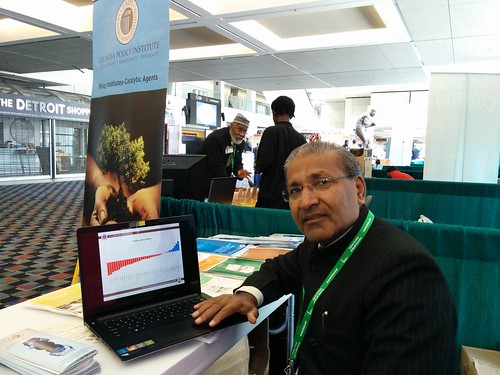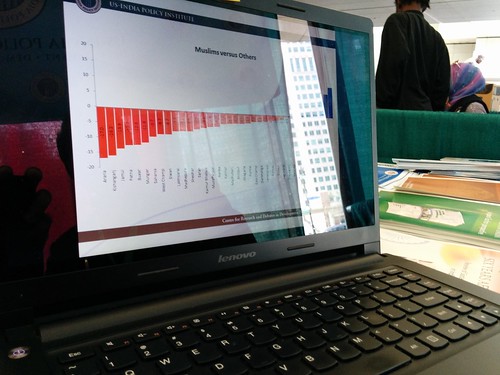By Kashif-ul-Huda, TwoCircles.net,
Detroit: “It’s a logical extension of Sachar Report’s methodology to highlight differentials in human development for indices for each socio-religious communities at the district level,” Dr. Abusaleh Shariff told me while explaining DDDIx, a new index that he is going to launch later this month to measure development and diversity at the district level in India.
Dr. Shariff was the main force behind Sachar Committee’s report that for the first time documented the socio-economic status of Muslims and compared with other communities. Sachar report analyzed data at the national and state level but now to capture the diversity of India, he is ready to go deeper and present easy to understand indexes that can measure development for each community at the district level.

Dr. Abusaleh Shariff explaining DDDIx
Dr. Shariff who is the Chief Scholar and Executive Director at Washington, DC based US-India Policy Institute jointly with its partner institute Centre for Research and Debates in Development Policy (CRDDP), New Delhi has developed a series of District Development and Diversity Indices(DDDIxs) that provide various measures of human development. Dr.Abusaleh Shariff, will officially launch the index at USIPI headquarters on September 24, 2014 in a presentation titled “Pathways to Link Communities with Governance – Development and Diversity Index for India”.
What is DDDIx and how can it be used? (information provided by USIPI)
The DDDIx is a set of composite estimates which encompasses four major quality of life dimensions: (1) Material wellbeing, measures in terms of ‘current consumption expenditures’, levels of poverty and wage incomes and so on; (2) Social and Physical infrastructure such as access to electricity, potable water, roads etc; (3) Educational Levels and accessibility and (4) Health care levels and accessibility. Data on these dimensions are extracted from a number of nationally representative sample surveys mostly the NSSO which are used to estimate the household consumption expenditures and incidence of poverty.
The DDDIx and estimates of its components provide a solid empirical backing for prudent development policy initiatives at the district level. The local self-governments such as the panchayats and nagarphalikhas can use these indices to negotiate both budgetary allocations and appropriate share in the funds made available from the centrally sponsored flagship programs. The civil society and community groups can use these data effectively to make their case for enhanced financial allocations and priority policy engagement. If used prudently, these estimates presented through maps, charts and graphics will become a revolutionary tool of policy engagement in India.

A closer look at DDDIx
Public policy approaches to development are generally limited to all India and its major states. Given the geographic expanse and population concentrations across India a meaningful development strategy which can address acute poverty, malnutrition, illiteracy, ill-health must occur at the level of the districts in India.
Further, hitherto development policy decisions were made using a combination of district level per-capita averages and a small set of indictors such as average rainfall and agricultural productivity. Little information at this level on the quality of life and human development were available in the past. In the recent past, however, dependable data on a number of qualitative aspects of human lives have become available at the level of the district. Such data can be extracted from the decadal Census (most recent 2011), the annual national sample surveys (large sample size surveys are done at about five years interval), the national health and family surveys and human development surveys of the NCAER.
Computing development indices at the level of the District is rare and far in-between. There are also no standardised methodologies that are devised to undertake district level economic, social and infrastructural reviews and evaluation. As an effort to fill this gap, during 2013-14 the USIPI, Washington D.C jointly with its associate the CRDDP, New Delhi, extracted district level data on 27 key variables pertaining to quality of life and gender equality expressed in terms of education, health, economic opportunities and physical infrastructure. The USIPI extended its analysis one step further by estimating a composite index and four indices of its main components according to ‘socio-religious categories’ which were created by the ‘Prime Minister’s High Level Committee-(2005-6). Such estimates allow comparisons, at the district level, in many facets of economic and social development between various socio-politically recognized communities of India.
Link:
http://www.usindiapolicy.org/
